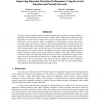Free Online Productivity Tools
i2Speak
i2Symbol
i2OCR
iTex2Img
iWeb2Print
iWeb2Shot
i2Type
iPdf2Split
iPdf2Merge
i2Bopomofo
i2Arabic
i2Style
i2Image
i2PDF
iLatex2Rtf
Sci2ools
RAID
1999
Springer
1999
Springer
Improving Intrusion Detection Performance using Keyword Selection and Neural Networks
The most common computer intrusion detection systems detect signatures of known attacks by searching for attack-specific keywords in network traffic. Many of these systems suffer from high false-alarm rates (often 100’s of false alarms per day) and poor detection of new attacks. Poor performance can be improved using a combination of discriminative training and generic keywords. Generic keywords are selected to detect attack preparations, the actual break-in, and actions after the break-in. Discriminative training weights keyword counts to discriminate between the few attack sessions where keywords are known to occur and the many normal sessions where keywords may occur in other contexts. This approach was used to improve the baseline keyword intrusion detection system used to detect user-to-root attacks in the 1998 DARPA Intrusion Detection Evaluation. It reduced the false alarm rate by two orders of magnitude (to roughly 1 false alarm per day) and increased the detection rate to r...
Computer Networks | Generic Keywords | Intrusion Detection | Intrusion Detection System | RAID 1999 |
Related Content
| Added | 04 Aug 2010 |
| Updated | 04 Aug 2010 |
| Type | Conference |
| Year | 1999 |
| Where | RAID |
| Authors | Richard Lippmann, Robert K. Cunningham |
Comments (0)

